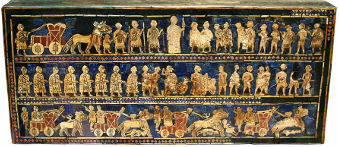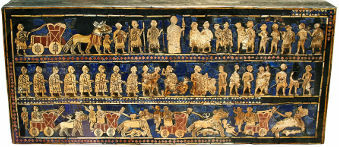Certainly, in Ancient History classes, you must have come across the theme of the rise of the civilizations of the Mesopotamia, that is, the Sumerian, Akkadian, Chaldean, Babylonian and Assyrian peoples. Well then, these civilizations, which developed in the region of the current countries of Iraq and Syria, between the Tigris and Euphrates rivers, bequeathed a vast cultural and artistic wealth. An example is the large architectural constructions called Ziggurats (Temples erected to worship gods and care by priests).
In addition to architectural monuments, other forms of art, such as relief art, sculpture and painting, flourished among these peoples. One of the most interesting examples of painting is the so-called “standard of ur”.
The "Ur Standard" consists of a trapezoidal (trapezoidal) box (or urn) with various images painted on its sides that contain scenes depicting various situations, such as war and the acclamation to the King. This box was found in the year 1928 by the British archaeologist sir Ç. Leonard Wooley, when I dug the Royal Cemetery of Ur, that is, the cemetery in which the Sumerian royalty was buried in the city of Ur in Mesopotamia (present-day Iraq).
The box and its paintings date from approximately 2600 BC. Ç. The material used to paint the scenes was basically shells, red limestone and lapis lazuli (a special type of bluish colored stone), as described by the art historian Stephenfarthing in the following excerpt:
Standing servants serve the king and nobles, and in the lower range a group of men take the spoils of war – a bull, a goat, fish and other loot – to the banquet. The shells used to portray people have delicate black embellishments, while flakes of lapis lazuli serve as a backdrop. Bits of red limestone were added for decorative purposes. [1]

Above, the box labeled "Ur Standard"
The name "Standard of Ur" was given by Wooley after finding the box, inside a tomb, on the bone of an individual who appeared to be carrying it on his back. Wooley started from the perspective that, in the ancient battles of Mesopotamia, armies had someone designated to carry on his back a box with the standard (a coat of arms tied to a wooden support) of the king. However, after a while, another hypothesis was raised: it is suspected that this box, in fact, served to accommodate a musical instrument.
Both sides of the "Standard of Ur" have specific titles. One of them is called “War Frame” and depicts battle scenes, and the other is the “Peace Frame”, which can be seen in the image in the center of the text.
GRADES
[1] Farthing, Stephen. All About Art. Rio de Janeiro, Sextant. 2010. P. 22.
By Me. Cláudio Fernandes

